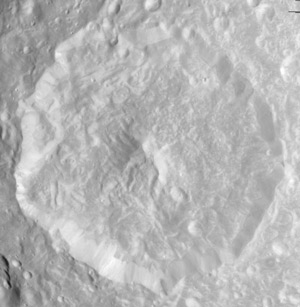Of all the moons in the solar system, Mimas is one of the most recognizable. And new pictures from Cassini show us again just why.
On Saturday, February 13, the Saturn probe dipped low over Mimas, sliding past the small moon at a distance of just 15,000 kilometers (9000 miles). For comparison, the Earth is about 13,000 km (8000 miles) across, so Cassini really threaded the needle with this pass.
On its way out from the encounter, when it was about 70,000 km (44,000 miles) from the moon, it snapped this astonishing shot:
Yegads. Note that this image is raw and unprocessed – it’s basically straight off the camera (and converted to JPG). But holy cow, there’s a lot to see. The giant crater Herschel is pretty obvious. It’s about 130 km (80 miles) across (compare that to Mimas itself, which is 400 km in diameter!), with a central peak characteristic of large impact basins. I think that’s where the main weapon is located.
 Mimas has clearly had an interesting past: it’s battered beyond belief, loaded with impact craters. In fact, one thing scientists hope to learn from this pass of the moon is a bit of its timeline. By counting up the number of craters inside Herschel, and comparing that to the crater counts outside of it, they can estimate its age. Fewer craters inside of Herschel means it’s younger than the surrounding surface, for example. But how much younger? Maybe we’ll soon know. And they’ll be able to see craters that are pretty small; the resolution in the image here is about 200 meters (1/8 mile) per pixel. That’s about the same as we can do on our own Moon from Earth!
Mimas has clearly had an interesting past: it’s battered beyond belief, loaded with impact craters. In fact, one thing scientists hope to learn from this pass of the moon is a bit of its timeline. By counting up the number of craters inside Herschel, and comparing that to the crater counts outside of it, they can estimate its age. Fewer craters inside of Herschel means it’s younger than the surrounding surface, for example. But how much younger? Maybe we’ll soon know. And they’ll be able to see craters that are pretty small; the resolution in the image here is about 200 meters (1/8 mile) per pixel. That’s about the same as we can do on our own Moon from Earth!
Sometimes with raw images like this, the background can be a little screwed up due to artifacts in the camera. But in this case, the glow on the left hand side of the big image is quite real: it’s the face of Saturn itself! The geometry of the shot was just right to capture a bit of the cloudtops of the ringed world. Very cool.
These are gorgeous pictures, and it’ll be nice to see them once they’re completely processed, too. We’ll learn a lot about the moon from them… and as far as Mimas goes, I just hope it’s not fully armed and operational. I suppose I shouldn’t be too worried though. After all, I used to bullseye womp rats in my T-16 telescope, and they’re not too much bigger than Mimas.
Image credit: NASA/JPL/Space Science Institute